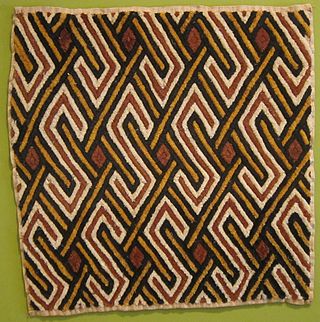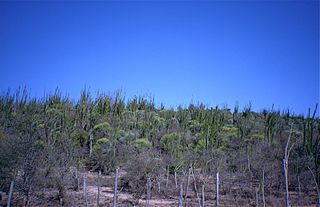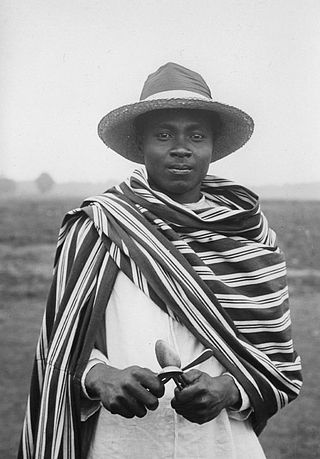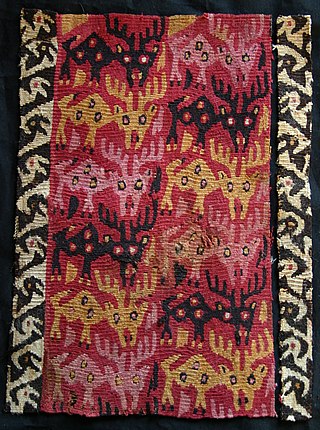Related Research Articles

The history of Madagascar is distinguished clearly by the early isolation of the landmass from the ancient supercontinent of Pangaea, containing amongst others the African continent and the Indian subcontinent, and by the island's late colonization by human settlers from the Sunda islands and from East Africa. These two factors facilitated the evolution and survival of thousands of endemic plant and animal species, some of which have gone extinct or are currently threatened with extinction. Trade in the Indian Ocean at the time of first colonization of Madagascar was dominated by Indonesian ships, probably of Borobudur ship and K'un-lun po types.

Weaving is a method of textile production in which two distinct sets of yarns or threads are interlaced at right angles to form a fabric or cloth. Other methods are knitting, crocheting, felting, and braiding or plaiting. The longitudinal threads are called the warp and the lateral threads are the weft, woof, or filling. The method in which these threads are interwoven affects the characteristics of the cloth. Cloth is usually woven on a loom, a device that holds the warp threads in place while filling threads are woven through them. A fabric band that meets this definition of cloth can also be made using other methods, including tablet weaving, back strap loom, or other techniques that can be done without looms.

Radama I "the Great" (1793–1828) was the first Malagasy sovereign to be recognized as King of Madagascar (1810–1828) by a European state. He came to power at the age of 17 following the death of his father, King Andrianampoinimerina. Under Radama's rule and at his invitation, the first Europeans entered his central highland Kingdom of Imerina and its capital at Antananarivo. Radama encouraged these London Missionary Society envoys to establish schools to teach tradecraft and literacy to nobles and potential military and civil service recruits; they also introduced Christianity and taught literacy using the translated Bible. A wide range of political and social reforms were enacted under his rule, including an end to the international slave trade, which had historically been a key source of wealth and armaments for the Merina monarchy. Through aggressive military campaigns he successfully united two-thirds of the island under his rule. Abuse of alcohol weakened his health and he died prematurely at age 35. He was succeeded by his highest-ranking wife, Ranavalona I.
Ikat is a dyeing technique from Indonesia used to pattern textiles that employs resist dyeing on the yarns prior to dyeing and weaving the fabric. The term is also used to refer to related and unrelated traditions in other cultures. In Southeast Asia, where it is the most widespread, ikat weaving traditions can be divided into two general clades. The first is found among Daic-speaking peoples. The second, larger group is found among the Austronesian peoples and spread via the Austronesian expansion. Similar dyeing and weaving techniques that developed independently are also present in other regions of the world, including India, Central Asia, Japan, Africa, and the Americas.

The Malagasy are a group of Austronesian-speaking ethnic groups indigenous to the island country of Madagascar. Traditionally, the population have been divided into ethnic groups. Examples include "Highlander" groups such as the Merina and Betsileo of the central highlands around Antananarivo, Alaotra (Ambatondrazaka) and Fianarantsoa, and the "coastal dwellers" with tribes like the Sakalava, Bara, Vezo, Betsimisaraka, Mahafaly, etc.

The Sakalava are an ethnic group of Madagascar. They are found on the western and northwest region of the island, in a band along the coast. The Sakalava are one of the smallest ethnic groups, constituting about 6.2 percent of the total population, that is about 2,079,000 in 2018. Their name means "people of the long valleys." They occupy the western edge of the island from Toliara in the south to the Sambirano River in the north.

Silk In India, about 97% of the raw mulberry silk is produced in the Indian states of Karnataka, Andhra Pradesh, Tamil Nadu and West Bengal. Mysore and North Bangalore, the upcoming site of a US$20 million "Silk City", contribute to a majority of silk production. Another emerging silk producer is Tamil Nadu in the place in where mulberry cultivation is concentrated in Salem, Erode and Dharmapuri districts. Hyderabad, Andhra Pradesh and Gobichettipalayam, Tamil Nadu were the first locations to have automated silk reeling units.
Articles related to Madagascar include:

African textiles are textiles from various locations across the African continent. Across Africa, there are many distinctive styles, techniques, dyeing methods, and decorative and functional purposes. These textiles hold cultural significance and also have significance as historical documents of African design.

Androy is the most southerly region of Madagascar. It covers an area of 19,540 km2, and had a population of 903,376 inhabitants in 2018. The administrative capital is Ambovombe-Androy.
Malagasy mythology is rooted in oral history and has been transmitted by storytelling, notably the Andriambahoaka epic, including the Ibonia cycle. At least 6% of Madagascar are adherents of the religion, which is known as Fomba Gasy, and surveys show it is likely at least half practice some aspects of it. Adherence to Fomba Gasy is high amongst the Sakalava people, as they are reluctant to convert to faiths of foreign origin.

The culture of Madagascar reflects the origins of the Malagasy people in Southeast Asia, East Africa and Oceania. The influence of Arabs, Indians, British, French and Chinese settlers is also evident.

Andriana was both the noble class and a title of nobility in Madagascar. Historically, many Malagasy ethnic groups lived in highly stratified caste-based social orders in which the andriana were the highest strata. They were above the Hova and Andevo (slaves). The Andriana and the Hova were a part of Fotsy, while the Andevo were Mainty in local terminology.

Malagasy is an Austronesian language and dialect continuum spoken in Madagascar. The standard variety, called Official Malagasy, is an official language of Madagascar alongside French. Malagasy is the westernmost Malayo-Polynesian language, originating in Madagascar with the settlement of Austronesian peoples from the Sunda islands around the 5th century AD. The Malagasy language is one of the Barito languages and is most closely related to the Ma'anyan language, still spoken on Borneo. Malagasy also includes numerous Malay loanwords, from the time of the early Austronesian settlement and trading between Madagascar and the Sunda Islands. After c. 1000 AD, Malagasy incorporated numerous Bantu and Arabic loanwords brought over by traders and new settlers.

The architecture of Madagascar is unique in Africa, bearing strong resemblance to the construction norms and methods of Southern Borneo from which the earliest inhabitants of Madagascar are believed to have immigrated. Throughout Madagascar, the Kalimantan region of Borneo and Oceania, most traditional houses follow a rectangular rather than round form, and feature a steeply sloped, peaked roof supported by a central pillar.

A lamba is the traditional garment worn by men and women that live in Madagascar. The textile, highly emblematic of Malagasy culture, consists of a rectangular length of cloth wrapped around the body.

The Bara people are a Malagasy ethnic group living in the southern part of the central plateaus of Madagascar, in the Toliara Province, concentrated around their historic capital at Ihosy. The Bara are the largest of the island's zebu-herding peoples and have historically lived a semi-nomadic lifestyle, although an increasing proportion are practicing agriculture. Bara society is highly patriarchal and endogamy and polygamy are practiced among some Bara tribes. Young men practice cattle rustling to prove their manhood before marriage, and the kilalaky musical and dance tradition associated with cattle rustlers has gained popularity across the island.
The Antaifasy are an ethnic group of Madagascar inhabiting the southeast coastal region around Farafangana. Historically a fishing and farming people, many Antaifasy were heavily conscripted into forced labor (fanampoana) and brought to Antananarivo as slaves under the 19th century authority of the Kingdom of Imerina. Antaifasy society was historically divided into three groups, each ruled by a king and strongly concentrated around the constraints of traditional moral codes. Approximately 150,000 Antaifasy inhabit Madagascar as of 2013.
The Tandroy are a traditionally nomadic ethnic group of Madagascar inhabiting the arid southern part of the island called Androy, tracing their origins back to the East Africa mainland. In the 17th century however, the Tandroy emerged as a confederation of two groups ruled by the Zafimanara dynasty until flooding caused the kingdom to disband around 1790. The difficult terrain and climate of Tandroy protected and isolated the population, sparing them from subjugation by the Kingdom of Imerina in the 19th century; later, the French colonial authority also struggled to exert its influence over this population. Since independence the Tandroy have suffered prejudice and economic marginalization, prompting widespread migration and intermarriage with other ethnic groups, and leading them to play a key role in protests that sparked the end of President Philibert Tsiranana's administration in 1972.

The textile arts of the Indigenous peoples of the Americas are decorative, utilitarian, ceremonial, or conceptual artworks made from plant, animal, or synthetic fibers by Indigenous peoples of the Americas.
References
- 1 2 3 4 5 6 7 8 9 10 11 12 13 14 15 16 17 18 19 20 21 22 23 24 25 26 Sarah Fee (2002). Christine Mullen Kreamer (ed.). Objects as envoys : cloth, imagery, and diplomacy in Madagascar : [...in conjunction with a 2002 exhibition "Gifts and Blessings : The Textile Arts of Madagascar", org. by the National Museum of African Art]. Washington, DC: Smithsonian Inst. ISBN 0295981962.
- ↑ Bortolot, Alexander Ives. "Kingdoms of Madagascar: Malagasy Textile Arts | Essay | Heilbrunn Timeline of Art History | The Metropolitan Museum of Art". The Met’s Heilbrunn Timeline of Art History. Retrieved 1 March 2018.
- ↑ Green, Rebecc L. (1996). "Divine Worth: Weaving and the Ancestors in Highland and Madagascar". Textile Society of America Symposium Proceedings. 848: 239–248.
- 1 2 3 4 Bortolot, Alexander Ives. "Kingdoms of Madagascar: Malagasy Textile Arts | Essay | Heilbrunn Timeline of Art History | The Metropolitan Museum of Art". The Met’s Heilbrunn Timeline of Art History. Retrieved 1 March 2018.